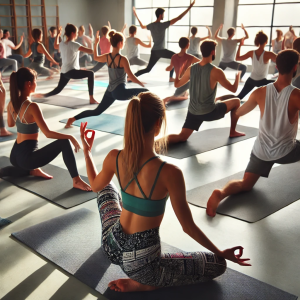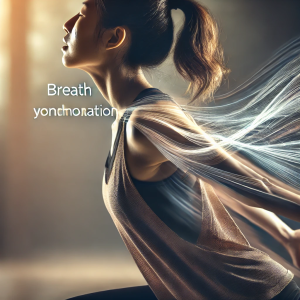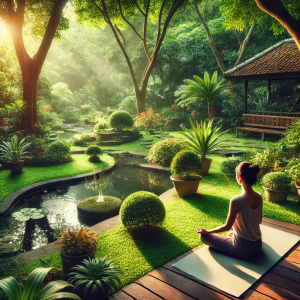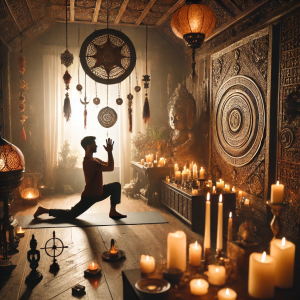By: Dr. Raj Patel, Tantric Yoga Instructor and Sexual Health Educator
Vinyasa Yoga, often referred to as “flow” yoga, is a dynamic and fluid form of yoga that emphasizes the seamless connection between breath and movement. Rooted in ancient traditions, Vinyasa Yoga offers a comprehensive approach to physical fitness, mental clarity, and spiritual growth. This article explores the principles, benefits, and practices of Vinyasa Yoga, providing insights into how it can be integrated into your daily routine for holistic health.

Understanding Vinyasa Yoga
The word “Vinyasa” is derived from the Sanskrit term “nyasa,” which means “to place,” and the prefix “vi,” which means “in a special way.” Together, they signify the mindful arrangement of movement and breath. Vinyasa Yoga involves a continuous flow of postures (asanas) coordinated with intentional breathing (pranayama), creating a moving meditation that enhances the mind-body connection.

Core Elements of Vinyasa Yoga
- Asanas (Physical Postures): Asanas in Vinyasa Yoga are performed in a flowing sequence, with each movement linked to an inhale or exhale. This dynamic practice builds strength, flexibility, and endurance. Common Vinyasa sequences include Sun Salutations (Surya Namaskar) and the Warrior series.
- Pranayama (Breath Control): Pranayama is a key component of Vinyasa Yoga, with breath guiding the movement. Techniques such as Ujjayi (Victorious Breath) create a rhythmic and calming effect, enhancing focus and energy flow.
- Meditation in Motion: Vinyasa Yoga is often described as a moving meditation. The continuous flow of postures and breath helps to quiet the mind and cultivate a state of presence and mindfulness.
- Transitions: Smooth transitions between poses are a hallmark of Vinyasa Yoga. These transitions are as important as the poses themselves, emphasizing grace and fluidity in movement.

The Benefits of Vinyasa Yoga
- Physical Fitness: Vinyasa Yoga enhances physical strength, flexibility, and cardiovascular health. The dynamic nature of the practice provides a full-body workout that improves muscle tone and endurance.
- Mental Clarity: The focus on breath and movement in Vinyasa Yoga promotes mental clarity and concentration. It helps to reduce mental clutter, enhance cognitive function, and improve overall mental well-being.
- Emotional Balance: Vinyasa Yoga supports emotional health by releasing tension and stress. The practice encourages mindfulness and self-awareness, helping individuals to manage their emotions and cultivate a positive outlook.
- Stress Relief: The combination of physical exertion and breath control in Vinyasa Yoga is effective in reducing stress and anxiety. It activates the parasympathetic nervous system, promoting a state of calm and relaxation.
- Spiritual Growth: Vinyasa Yoga provides a pathway to spiritual growth by fostering a deeper connection with the self and the universe. The practice encourages introspection, self-discovery, and a sense of unity with the divine.

Incorporating Vinyasa Yoga into Your Daily Routine
To fully benefit from Vinyasa Yoga, it is important to incorporate it into your daily routine. Here are some tips to get started:
- Create a Dedicated Space: Designate a quiet and peaceful area in your home for your yoga practice. This space can include a yoga mat, props (like blocks and straps), and items that inspire you, such as candles, crystals, and spiritual symbols.
- Set a Regular Practice Time: Establish a consistent time each day for your Vinyasa Yoga practice. Morning or evening sessions are ideal for setting a positive tone for the day or unwinding before sleep.
- Start with Simple Sequences: Begin with simple and accessible sequences, gradually progressing to more challenging flows as your practice evolves. Focus on alignment and breath control in each pose.
- Incorporate Breathwork: Include pranayama exercises in your practice to enhance the flow of energy and calm the mind. Spend a few minutes on breath control techniques before or after your asana practice.
- End with Relaxation: Always conclude your practice with a relaxation pose, such as Savasana. This allows the body and mind to integrate the benefits of the practice and promotes a sense of peace and well-being.

Exploring Advanced Vinyasa Yoga Practices
As you become more comfortable with Vinyasa Yoga, you may want to explore advanced practices to deepen your experience. Here are some techniques to consider:
- Bandhas (Energy Locks): Bandhas are techniques that lock and direct the flow of energy within the body. Practicing bandhas like Mula Bandha (Root Lock), Uddiyana Bandha (Abdominal Lock), and Jalandhara Bandha (Chin Lock) can enhance the effects of asanas and pranayama.
- Mudras (Hand Gestures): Mudras are symbolic hand gestures used to direct energy and focus the mind. Common mudras in Vinyasa Yoga include Gyan Mudra (Knowledge Gesture) and Anjali Mudra (Prayer Gesture).
- Mantras and Chanting: Incorporating mantras and chanting into your practice can elevate the spiritual aspect of Vinyasa Yoga. Chanting sounds like “Om” or reciting traditional mantras can create positive vibrations and deepen your connection with the divine.
- Advanced Asanas: As your practice progresses, you can explore more advanced asanas that require greater strength, flexibility, and balance. Poses like Bakasana (Crow Pose), Sirsasana (Headstand), and Natarajasana (Dancer Pose) challenge the body and mind, promoting growth and transformation.

The Role of a Vinyasa Yoga Teacher
A knowledgeable and experienced Vinyasa Yoga teacher can greatly enhance your practice. They can provide guidance on proper alignment, offer personalized modifications, and support your spiritual growth. Consider joining a Vinyasa Yoga class or seeking private instruction to deepen your understanding and experience of the practice.
Incorporating Vinyasa Yoga with Other Practices
Vinyasa Yoga can be seamlessly integrated with other spiritual and wellness practices to enhance its benefits:
- Ayurveda: The ancient science of Ayurveda complements Vinyasa Yoga by providing dietary and lifestyle guidelines that align with your dosha (body constitution). This integration can enhance overall health and balance.
- Meditation: Combining Vinyasa Yoga with meditation practices like mindfulness or Vipassana can deepen your spiritual experience and promote inner peace.
- Reiki: Incorporating Reiki, a form of energy healing, with Vinyasa Yoga can amplify the flow of prana and support emotional and physical healing.
- Nutrition: Following a balanced and nutritious diet that supports your yoga practice can improve energy levels, enhance performance, and support overall well-being.

Personal Transformation through Vinyasa Yoga
Embarking on a journey with Vinyasa Yoga can lead to profound personal transformation. As you commit to regular practice, you may notice improvements in physical fitness, mental clarity, emotional balance, and spiritual growth. The discipline and mindfulness cultivated through Vinyasa Yoga can extend to other areas of your life, promoting holistic well-being and a deeper connection with yourself and the world around you.

Conclusion
Vinyasa Yoga is a holistic practice that balances the body and mind, offering numerous benefits for physical fitness, mental clarity, emotional balance, and spiritual growth. By incorporating Vinyasa Yoga into your daily routine, you can experience the transformative power of this dynamic discipline. Whether you are a beginner or an advanced practitioner, Vinyasa Yoga provides a pathway to well-being and harmony in mind, body, and spirit.
Dr. Raj Patel is an esteemed Tantric Yoga instructor and sexual health educator with a Ph.D. in Eastern Philosophy and Holistic Health. With over 15 years of experience, he specializes in teaching Tantric Yoga practices that integrate spiritual and sexual well-being. Dr. Patel's workshops and private sessions focus on enhancing sexual vitality through the principles of Tantric Yoga, helping individuals and couples achieve a harmonious balance between their spiritual and sexual lives. His approach combines ancient Tantric teachings with contemporary health practices to promote deeper intimacy and overall wellness.


